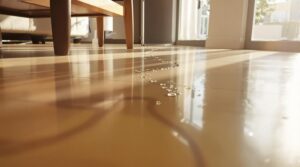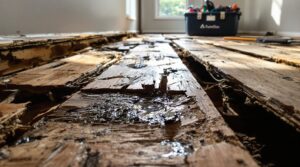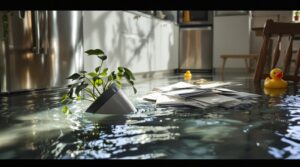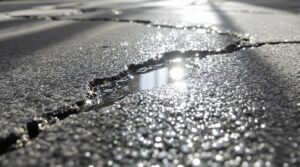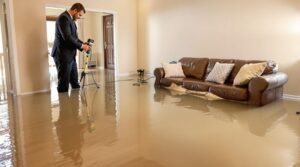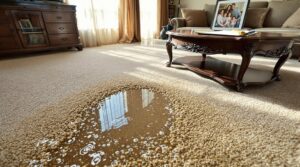Insurance typically covers water damage to wood floors caused by sudden and unexpected events like burst pipes, appliance failures, or roof leaks. Coverage includes emergency drying procedures and repairs with similar quality materials under standard dwelling coverage (Coverage A). However, damage from floods, long-term exposure, or poor maintenance is usually excluded. Documentation through photos, videos, and maintenance records greatly impacts claim success. Working with public adjusters can maximize settlement outcomes and uncover additional coverage provisions.
Key Takeaways
- Insurance typically covers water damage to wood floors from sudden events like burst pipes, appliance failures, and unexpected roof leaks.
- Coverage excludes flooding from ground-level water sources and damage resulting from long-term water exposure or poor maintenance.
- Successful claims require prompt reporting, thorough documentation with photos, and proof that damage wasn't due to negligence.
- Insurance will cover emergency drying procedures and repairs using materials of similar quality to the damaged flooring.
- Both direct damage to hardwood floors and consequential damage to subfloors are covered under standard dwelling coverage policies.
Understanding Your Insurance Coverage for Wood Floor Damage
When water damages hardwood floors, understanding insurance coverage becomes critical for homeowners seeking compensation. Most insurance policies include Dwelling Coverage (Coverage A), which specifically addresses structural damage, including water damage to wood floors caused by sudden and unexpected events.
Insurance providers typically cover water damage resulting from perils such as burst pipes or roof leaks, provided the damage occurs within a 14-day timeframe. However, coverage does not extend to flood damage from ground-level water sources.
The policy will generally cover the costs of emergency drying procedures, repair or replacement of damaged areas with similar quality materials, and necessary subfloor replacement.
For successful claims, homeowners must document the damage thoroughly and obtain professional assessments. Insurance adjusters evaluate the extent of damage and determine claim values based on policy specifications.
Understanding these coverage parameters helps homeowners navigate the claims process effectively and secure appropriate compensation for their damaged wood floors.
Types of Water Damage Typically Covered by Insurance
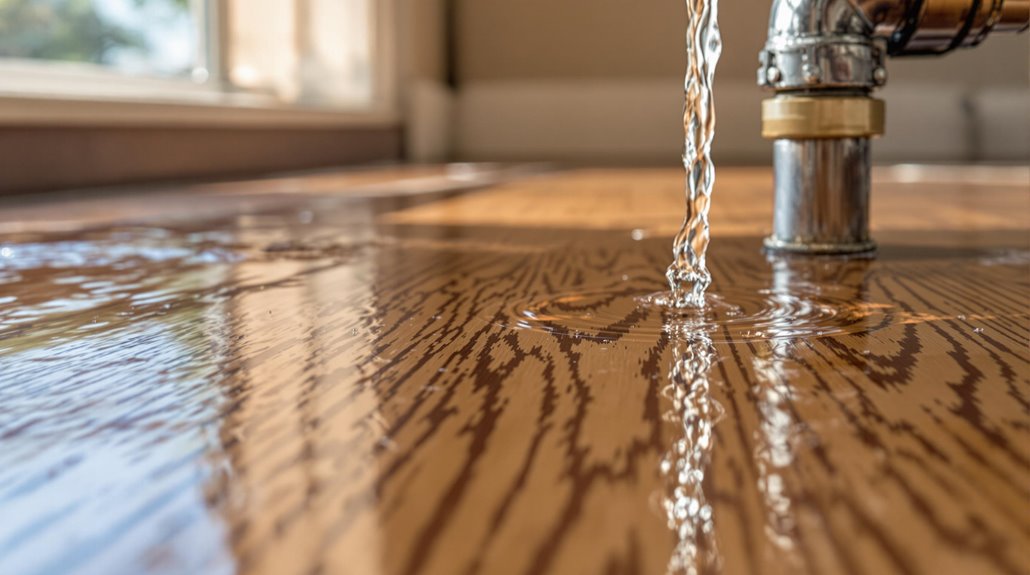
Standard homeowners insurance policies provide coverage for various types of water damage, with specific classifications determining eligibility for claims. Insurance policies typically extend protection across multiple scenarios, including sudden plumbing failures, storm-related incidents, and accidental overflows.
Key categories of covered water damage include:
- Sudden and accidental discharges from burst pipes, water heater ruptures, and appliance failures
- Overflow incidents involving toilets, sinks, and unexpected plumbing system discharges
- Storm-induced damage from rain, hurricanes, tornados, and roof leaks
Coverage extends to both direct and consequential damage, encompassing repairs to hardwood floors, subfloors, and ceiling structures affected by covered water incidents.
Insurance policies often include provisions for emergency drying procedures and restoration of attached structures damaged by water intrusion. Understanding these coverage parameters helps homeowners navigate the claims process effectively when water damage occurs.
Steps to File a Successful Wood Floor Insurance Claim

Successful wood floor insurance claims require systematic documentation of all water damage through exhaustive photos, videos, and detailed records of affected areas.
Filing the claim promptly after discovering water damage allows insurance providers to begin assessment procedures without delay.
Insurance companies evaluate claims based on provided evidence, making thorough documentation essential for demonstrating the extent of damage and supporting the necessity of repairs or replacement.
Document Everything Thoroughly
Properly documenting water damage to hardwood floors serves as a critical foundation for filing a successful insurance claim. Thorough damage documentation requires capturing immediate photographs, maintaining detailed records of all communications with insurance providers, and collecting professional assessment reports. These elements strengthen the claim's validity and support negotiations for fair compensation.
- Take extensive photographs and videos of all affected areas, including close-up shots of damaged flooring and subfloor conditions.
- Maintain chronological records of all conversations, emails, and correspondence with insurance adjusters and contractors.
- Collect and organize all receipts, invoices, and professional evaluation reports related to the damage assessment and repair process.
This systematic approach to claim strategies enhances the likelihood of successful coverage while ensuring compliance with insurance policy requirements.
File Claims Without Delay
Having established proper documentation practices, homeowners must act swiftly when filing insurance claims for water-damaged hardwood floors. The claim filing process begins with a thorough damage assessment, reviewing policy coverage specifics, and understanding applicable deductibles and limitations.
Property owners should immediately contact their insurance provider through designated channels, whether by phone, online portals, or direct communication with their agent.
The process typically involves scheduling inspections with insurance adjusters and obtaining multiple contractor estimates for repairs. During this phase, homeowners must comprehend their settlement options, particularly the differences between Actual Cash Value and replacement cost coverage.
Understanding policy limits and specific coverage parameters for water damage versus flood damage guarantees appropriate claim submission and maximizes the potential for successful settlement.
Documenting Water Damage for Maximum Coverage

Thorough documentation of water damage plays a critical role in securing maximum insurance coverage for property losses. Insurance adjusters rely heavily on detailed evidence when processing claims, making extensive documentation essential for achieving ideal compensation. Property owners must systematically record all aspects of water damage through multiple methods of documentation.
- Capture extensive visual evidence through photographs and videos, focusing on the damage source, affected areas, and individual items.
- Create a detailed inventory list with precise descriptions of damaged items, including pre-damage condition and estimated replacement costs.
- Maintain organized records of all expenses, professional assessments, and communications with insurance representatives.
The documentation process requires preserving damaged items until an insurance adjuster completes their inspection.
All repair receipts, professional service invoices, and restoration expenses must be retained. This systematic approach to documentation considerably strengthens the claim's validity and increases the likelihood of receiving appropriate compensation for water-damaged wood flooring and other affected property.
Working With Insurance Adjusters on Wood Floor Claims
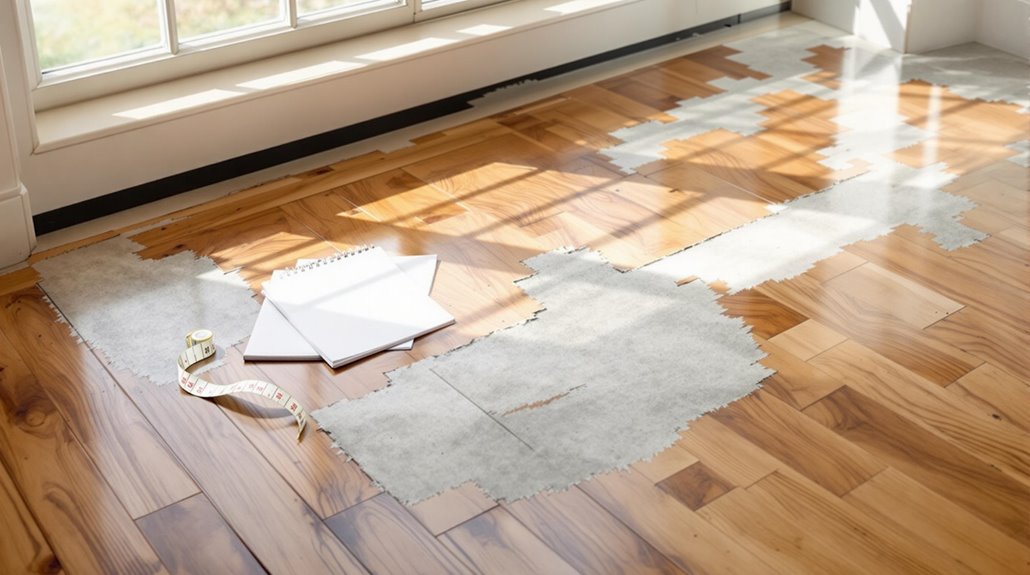
Prior to the insurance adjuster's arrival, homeowners should thoroughly photograph and document all water damage to wood flooring, including any buckling, cupping, or discoloration patterns.
Presenting detailed documentation that includes maintenance records, pre-existing floor conditions, and multiple contractor repair estimates strengthens the homeowner's position during the claims process.
The final settlement negotiation requires careful attention to guarantee coverage for both direct water damage repairs and any necessary matching of undamaged sections to maintain uniformity throughout the flooring system.
Documentation Before Adjuster Arrives
Proper documentation before an insurance adjuster's arrival serves as a critical foundation for successful wood floor damage claims.
Property owners must systematically gather evidence to support their water damage insurance claims through extensive documentation methods.
Key documentation requirements include:
- Detailed photographic evidence capturing both close-up and wide-angle shots of affected wood flooring
- Written records noting water source, damage extent, and immediate mitigation steps taken
- Organized compilation of all receipts, invoices, and expenses related to emergency repairs
This systematic approach to documentation strengthens the claim by providing verifiable evidence of damage extent and mitigation efforts.
Maintaining thorough records of all communications with insurance providers and collecting relevant maintenance history helps establish context for the adjuster's assessment.
Negotiating Final Settlement Terms
Negotiating final settlement terms with insurance adjusters requires a structured approach built upon the foundation of thorough documentation. Effective settlement strategies involve reviewing initial offers against policy terms, gathering supporting evidence, and preparing detailed counteroffers when necessary.
Property owners should implement specific negotiation tactics, including requesting itemized breakdowns of settlement calculations and presenting organized documentation of damage assessments.
Understanding policy exclusions and limitations enables more effective discussions about coverage. When settlement offers appear inadequate, policyholders can strengthen their position by providing expert opinions, detailed repair estimates, and extensive photographic evidence.
For complex cases, engaging a public adjuster or legal professional can enhance negotiating leverage and guarantee fair compensation for water-damaged wood flooring claims.
Common Reasons for Denied Wood Floor Claims
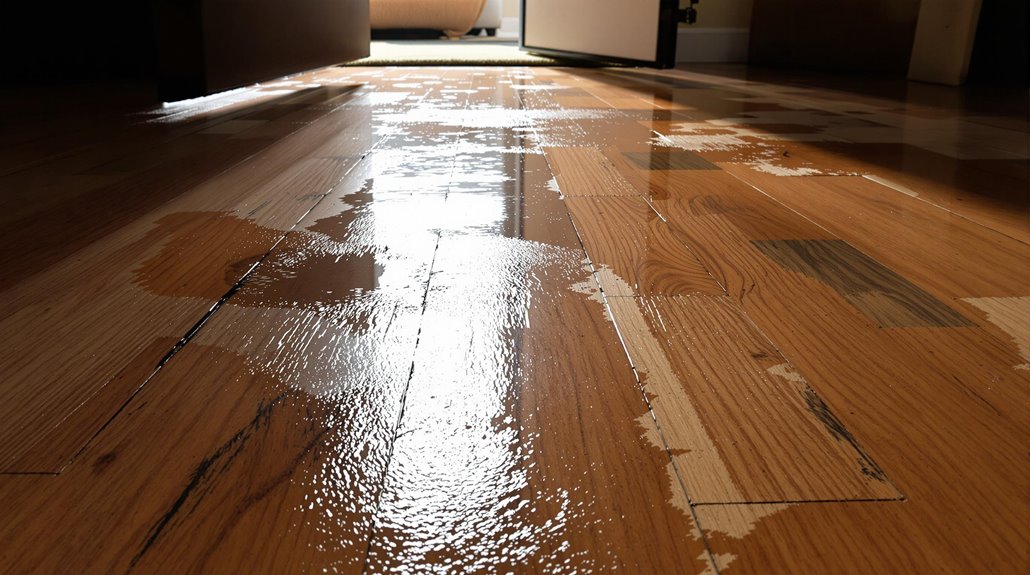
When homeowners file insurance claims for water-damaged wood floors, they often encounter various challenges that can lead to claim denials. Understanding common exclusions and claim process challenges is essential for managing insurance policies effectively.
Insurance companies frequently deny claims due to specific policy limitations, inadequate documentation, or maintenance-related issues.
Key reasons for wood floor claim denials include:
- Long-term water exposure exceeding 14 days, which may lead to mold growth
- Pre-existing conditions or lack of proper maintenance documentation
- Damage from excluded perils like floods or earthquakes without specific coverage
Documentation plays a vital role in the approval process, with insurers requiring detailed evidence of the damage, its cause, and timely reporting.
Claims may be rejected due to insufficient proof, late filing, or incomplete submissions. Additionally, homeowners must demonstrate they have maintained their floors properly and addressed any known issues promptly to avoid denial based on negligence.
Choosing the Right Contractor for Insurance-Covered Repairs

Selecting a qualified contractor for insurance-covered wood floor repairs requires careful evaluation of multiple critical factors to guarantee successful restoration. Homeowners must verify contractor qualifications, including relevant experience, certifications, and licenses specific to water damage restoration.
Additionally, contractors should maintain extensive liability insurance and workers' compensation coverage.
Property owners have two primary options: utilizing the insurance company's preferred contractor or selecting an independent professional. Both approaches require detailed documentation of damage, transparent cost estimates, and clear repair warranties.
The chosen contractor should demonstrate expertise in coordinating with insurance providers and managing the claims process effectively.
Essential considerations include reviewing the contractor's reputation through references and past work examples, obtaining multiple estimates for comparison, and ensuring the selected professional can work within insurance-approved budgets.
The contractor must also provide detailed documentation throughout the restoration process and guarantee workmanship that meets insurance standards.
Preventing Future Water Damage to Protect Your Coverage
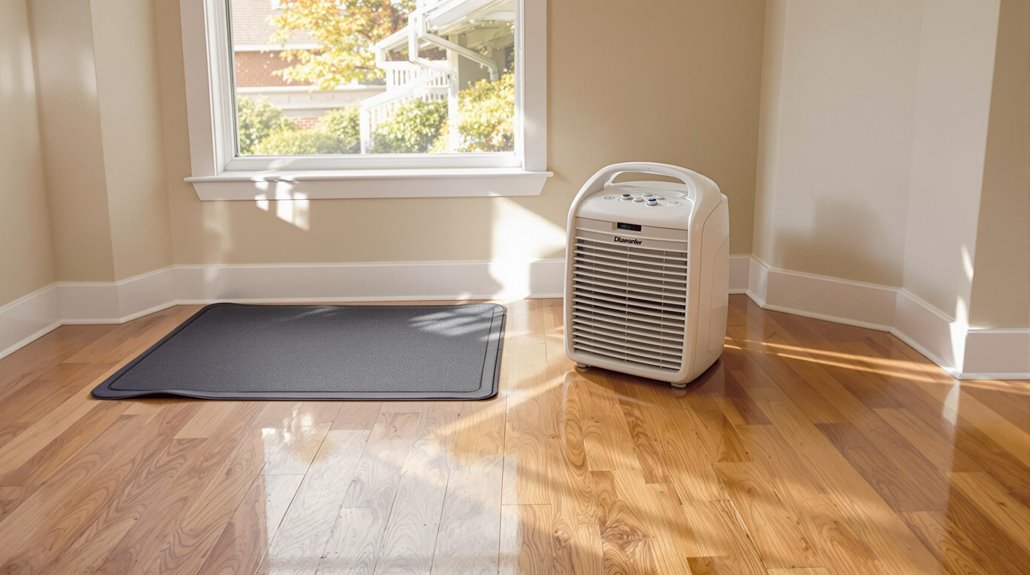
To maintain insurance coverage and protect hardwood floors from water damage, homeowners must implement thorough preventive measures throughout their properties. Regular preventive maintenance and moisture control strategies are essential for preserving both the structural integrity of the home and insurance eligibility.
- Establish a detailed inspection routine that includes checking pipes, foundations, roofs, and walls for potential water intrusion points.
- Install protective barriers such as properly sealed windows, water-resistant floor sealants, and strategic placement of mats in moisture-prone areas.
- Maintain ideal indoor humidity levels between 45-55% using dehumidifiers and ventilation systems.
Implementing these measures requires consistent monitoring and immediate response to water-related issues. Proper maintenance includes regular cleaning with appropriate materials, avoiding harsh chemicals, and promptly addressing spills.
Additionally, installing ventilation fans in high-humidity areas and maintaining functional gutters and downspouts helps prevent water accumulation that could compromise both the flooring and insurance coverage.
The Benefits Of Consulting A Public Adjuster
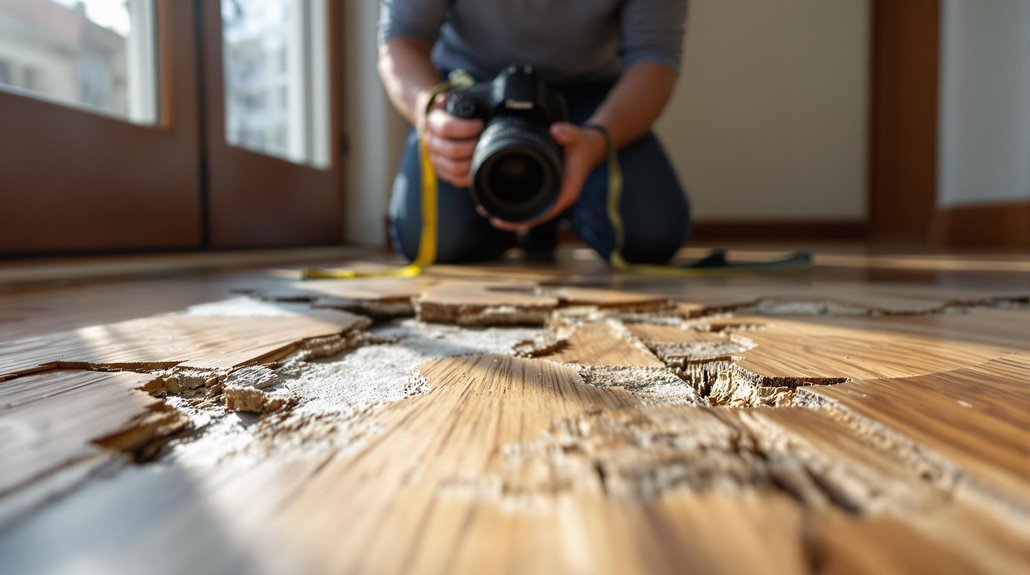
Public adjusters provide specialized expertise in maneuvering complex insurance claims through objective damage assessments and detailed documentation of water-related losses.
Their methodical approach streamlines the claims process by managing communications with insurers, gathering evidence, and interpreting policy provisions.
Statistical data indicates that professional adjusters frequently secure higher claim settlements compared to policyholders who handle claims independently, often resulting in payouts 30-40% above initial insurance company offers.
Expertise In Insurance Claims
The expertise of a public adjuster offers significant advantages for policyholders maneuvering complex insurance claims for water damage. Through detailed claim evaluation and thorough policy analysis, these professionals guarantee that all aspects of water damage to wood floors are properly documented and covered under applicable policy terms.
- Public adjusters possess in-depth knowledge of insurance policies, enabling them to identify coverage provisions that property owners might overlook.
- Their expertise in documentation and damage assessment strengthens the claim's validity.
- They utilize professional negotiation skills to secure ideal settlements while countering potential low-ball offers.
Their thorough understanding of insurance procedures and claim processes allows for efficient handling of complex situations, particularly in cases involving extensive water damage to wooden flooring, where proper documentation and expert evaluation are essential for successful claims.
Objective Damage Assessment
Skilled damage assessment by professional public adjusters provides property owners with extensive evaluations that uncover both visible and concealed water damage.
Through the utilization of advanced diagnostic tools, including moisture meters and thermal imaging equipment, public adjusters document thorough evidence of affected areas.
These professionals excel in policy interpretation, ensuring all covered damages are properly identified and documented.
Their systematic approach includes collaboration with restoration experts and structural engineers to determine the full scope of water damage.
Public adjusters meticulously assess secondary issues such as mold growth, structural weakening, and material degradation that may not be immediately apparent.
This detailed documentation and expert analysis strengthen the claim's validity, providing vital evidence for negotiations with insurance carriers and establishing an accurate restoration cost assessment.
Streamlined Claim Process
When property owners face water damage claims, engaging a public adjuster streamlines the complex insurance process through thorough claim management services.
These licensed professionals facilitate efficient communication with insurance companies while managing documentation and negotiations to secure fair settlements.
Key benefits of professional claim management include:
- Expert handling of paperwork and policy interpretation
- Detailed documentation of water damage to wood flooring
- Strategic negotiation with insurance carriers for ideal settlements
Proper adjuster selection involves verifying state licensure, reviewing experience with similar claims, and understanding fee structures.
Public adjusters typically operate on contingency fees, receiving payment only upon successful claim resolution.
Their expertise in maneuvering regulatory requirements and insurance procedures helps guarantee compliance while expediting the claims process for water-damaged properties.
Higher Claim Payouts & Settlements
Public adjusters consistently demonstrate their value in water damage claims by securing considerably higher settlements compared to policyholder-managed claims. Their expertise in accurate damage assessment guarantees all water-related impacts on wood flooring are thoroughly documented and properly valued, including hidden damages that might otherwise go unnoticed.
Through skilled claim negotiation with insurance companies, public adjusters leverage their extensive understanding of policy terms and industry procedures to maximize compensation. They meticulously prepare documentation, gathering detailed repair estimates and proof of loss evidence to support higher settlement amounts.
Their professional representation includes strategic advocacy during negotiations, countering insurance company tactics that might minimize payouts. This expertise, combined with their regulatory knowledge and thorough property evaluation skills, typically results in substantially improved settlement outcomes for water-damaged wood floors.
About The Public Claims Adjusters Network (PCAN)
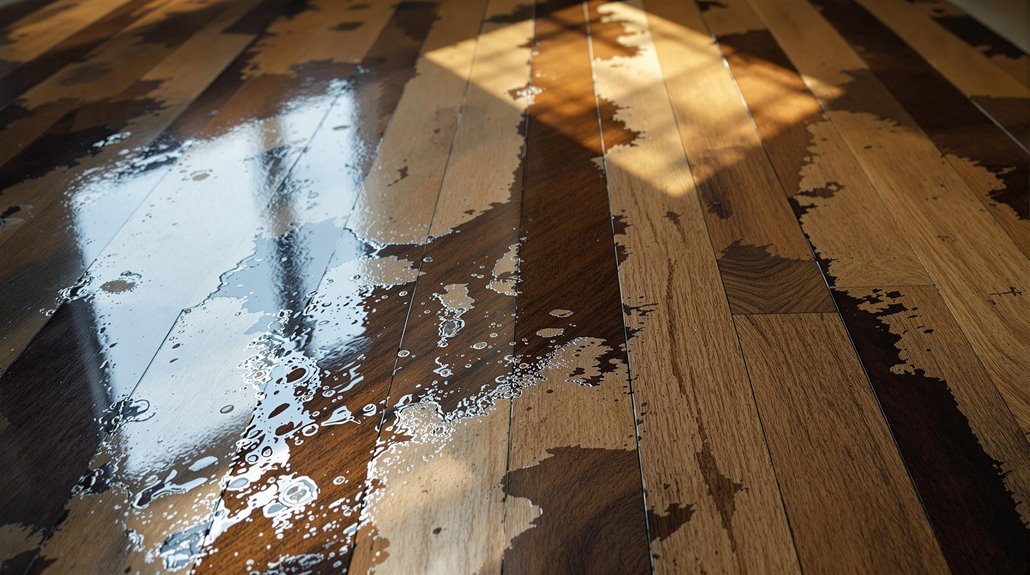
The Professional Claims Adjusters Network (PCAN) operates as a specialized organization dedicated to providing extensive insurance claim management services for policyholders. Through their expertise in claim processes and advocacy, PCAN guarantees broad representation while adhering to strict regulatory requirements and disclosure obligations.
Key Public Adjuster Benefits through PCAN include:
- Contingency-based services with no upfront fees
- Expert damage assessment and documentation
- Continuous support via 24/7 call center access
PCAN maintains transparency by providing detailed contracts that outline terms, compensation structures, and cancellation rights. Their adjusters must disclose any financial interests in related firms and communicate settlement offers within specified timeframes.
The organization's thorough approach includes expert claims handling, trial preparation assistance, and subrogation services. All expenses approved by the insured are reimbursed through insurance proceeds, guaranteeing cost-effective claim management while maximizing potential settlements for policyholders.
Frequently Asked Questions
Does Insurance Cover Water Damage From Neighbor's Unit in Multi-Story Buildings?
Standard insurance policies typically cover water damage from neighboring units in multi-story buildings, with claims processed through the affected party's insurer first to avoid direct neighbor disputes.
Can I Choose Premium Flooring Materials if Insurance Covers Replacement?
Insurance coverage extends to equivalent flooring materials within policy limits. Homeowners can select premium flooring options but must personally cover costs exceeding the original flooring's value during replacement.
Will Insurance Rates Increase After Filing a Water Damage Claim?
Filing a water damage claim typically triggers premium adjustments, with rates increasing 7-10% on average. Multiple claims within a short period can considerably impact future insurance costs through the claims process.
Does Insurance Cover Temporary Relocation During Extensive Floor Repairs?
Insurance policies typically provide temporary housing coverage and repair cost reimbursement through Additional Living Expenses provisions when extensive floor repairs render a home temporarily uninhabitable, subject to policy limits and documentation requirements.
Are Steam Cleaner Accidents Considered Covered Water Damage Events?
Steam cleaner liability is typically covered under insurance policies when damage occurs suddenly and accidentally. Cleaning equipment insurance protects against unexpected malfunctions, provided they aren't due to gradual wear or neglect.

